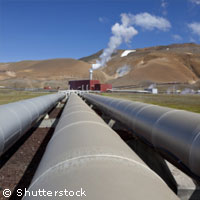Study finds mines can work for geothermal power
Is there light at the end of the tunnel for mine shafts slated for closure? Two Spanish engineers say there is, noting that they could be the sites for geothermal energy providing power to towns that need it. Writing in the journal Renewable Energy, the researchers describe the tool that enabled them to estimate the amount of heat a tunnel could potentially offer industry and households. The engineers from the University of Oviedo in Spain developed a new method to estimate how much heat could be generated by a mine tunnel whose life expectancy is not great. It should be noted that the use of geothermal energy, which draws on the Earth's natural heat, is not common in Spain. 'One way of making use of low-intensity geothermal energy is to convert mine shafts into geothermal boilers, which could provide heating and hot water for people living nearby,' Rafael Rodríguez of the School of Mines at the University of Oviedo was quoted as telling SINC (Scientific News and Information Service). 'When the mine is still active one can access the tunnels easily in order to gather data about ventilation and the properties of the rocks, as well as to take samples and design better circuits, and even programme the closure of the some sections in order to use them for geothermal energy production,' he added. Although geothermal power can be generated once a mine has been commissioned, 'it is no longer possible by that stage to make any modifications [to the mine], or to gather any useful data to evaluate and improve the system.' Unlike other systems that have been put forward, the new system developed by the Spanish scientists highlights the importance of taking action before the closure of the mines, while underground galleries are still accessible. Mr Rodríguez and his colleague María Belarmina Díaz investigated the geothermal exploitation of a two-kilometre-long mine shaft. According to their analyses, the temperature of the rocks located 500 metres below the surface stands at some 30°C. The majority of mining areas in Asturias, which is situated on the Spanish north coast facing the Cantabrian Sea, record temperatures of some 30°C. The engineers noted however that this temperature can also be applied to other regions. The authors write that the system could be used in areas where mines are likely to close in the near future. Such areas can be found across Spain and the rest of Europe, the researchers noted. SINC quoted them as saying that water could be forced in through tubes at 7°C and return at 12°C, constituting a sufficient heat gain that would prove advantageous for the towns located above the mines. Construction of geothermal boilers in mine shafts would be beneficial because not only would they generate power but they would function as an open tube system 'without any risk of heat contamination of aquifers', the researchers said. Users of geothermal energy would include industrial units, fish farms, family homes and housing developments. Geothermal energy would help curb carbon dioxide emissions. Other positive elements are that contrary to solar or wind power, geothermal isn't dependent on climate conditions, it doesn't need new developments on large sites and it doesn't pollute the immediate environment. From an industry perspective, geothermal energy would prove lucrative in the long run.
Countries
Spain, Italy



